Classification of electric transfer cart
In today's industrial transportation field electric transfer carts play a pivotal role, and customized designs can meet the complex and evolving production needs of various enterprises.
Rail Transfer Cart
Let's first discuss the rail transfer cart an electric transfer cart designed to operate on tracks. It relies on track transportation and offers a wide range of carrying capacities, from 1 ton to 1,000 tons, making it adaptable to the transportation tasks of workpieces of different weights.
Rail transfer carts are generally divided into several types based on their power supply methods. Each power supply method has distinct characteristics and advantages. Users can choose the appropriate type of rail transfer cart based on their factory’s transportation materials and environment.
1. Battery-Powered Rail Transfer Cart
The battery-powered rail transfer cart is a very popular transportation model. It eliminates the need for fixed power lines by drawing power from its own battery (we typically recommend maintenance-free batteries; for high-frequency transportation, lithium batteries are recommended). This allows the vehicle to move more flexibly and freely on the track.
In environments where workshop layouts are complex or transportation routes need to be changed frequently, the battery-powered rail transfer cart is an ideal solution.
For example, in small machining workshops, where the workpiece processing procedures are relatively scattered and the factory layout is compact, this rail trolley can quickly shuttle between workstations along the track, transporting processed workpieces to the next station in a timely manner. Additionally, operators do not need to worry about tangled power cords, which significantly improves production efficiency. At the same time, battery charging technology continues to advance, and the fast-charging feature allows the vehicle to recharge during short downtimes, ensuring continuous production.
Case:
Carrying capacity: 30 tons
Workbench size: 4000 mm × 2500 mm
Ground clearance: 500 mm
Transport distance: 150 m, transporting materials between 2-3 workstations
Power supply: Battery drive
Voltage: 220V
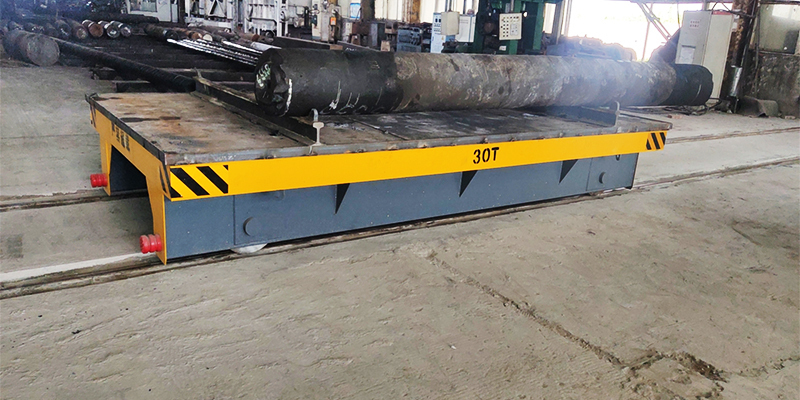
2. Rail-Powered Transfer Cart
The rail-powered transfer cart uses a safe and reliable power supply method. Power is transmitted to the transfer trolley through low-voltage rails. This method not only ensures a stable power supply for the vehicle but also reduces safety risks, such as electric shock. In some industrial environments with high safety requirements—such as chemical plants or production sites dealing with flammable or explosive materials—a low-voltage powered transfer cart is an ideal choice.
It can smoothly transport various chemical raw material barrels, reactors, and other heavy objects while ensuring safety, supporting the safe production of the enterprise. Furthermore, the low-voltage rail power supply system is stable and less prone to interference from external electromagnetic factors. This ensures reliable vehicle operation and reduces the risk of transportation failures caused by power fluctuations.
Case: Paper Roll Processing Plant Transports Paper Rolls and Round Castings
Carrying capacity: 10 tons
Workbench size: 5000 mm × 2000 mm
Ground clearance: 500 mm
Track gauge: 1600 mm
Transport distance: 200 m, transporting between the processing area and the finished product area
Power supply: Low-voltage rail power supply
Voltage: 220V
Features: High-frequency transportation at the customer site, two-shift work schedule. This power supply method meets high-frequency transportation requirements.
3. Cable-Powered Rail Transfer Cart / Cable Line Railway Trolley
The cable-powered rail transfer cart is another common type. It is connected to a fixed power supply through a cable drum. As the vehicle moves, the cable drum automatically retracts and releases the cable to ensure that the rail transfer cart always has a stable power supply. This method is ideal for long-distance, fixed-route transportation operations.
For example, in the rolling workshop of a large steel plant, steel billets need to be transported from the heating furnace to the rolling mill and then to subsequent cooling, finishing, and other processes. The transportation route is long and relatively fixed. The cable drum-powered railcar can efficiently complete the transfer task of steel billets along the track, and its high carrying capacity can easily manage the weight of the steel billets, ensuring the continuity of steel production.
Case: Rail Transfer Cart for Transporting Round Coil Products in an RGV Factory
Carrying capacity: 50 tons
Workbench size: 4000 mm × 2000 mm
Ground clearance: 500 mm
Track gauge: 1435 mm
Transport distance: 100 m, transporting between 8 stations
Power supply: Cable drum power supply
Voltage: 380V
Features: The customer transports cylindrical coil products on-site. Powered by cable drums, the transportation is automated, covering a total of 8 stations with automatic docking.
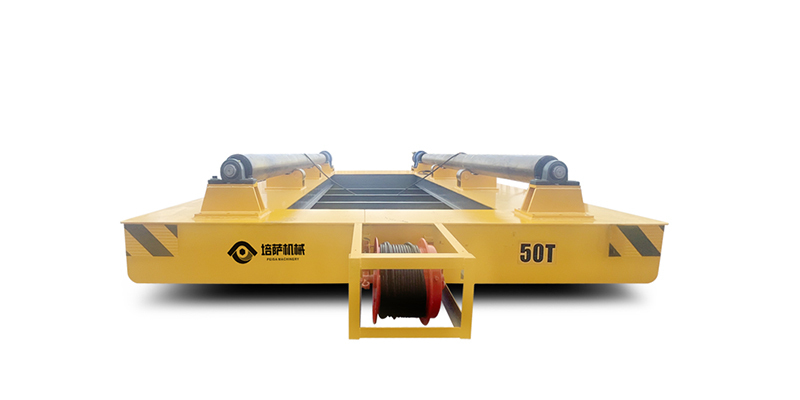
Trackless Transfer Cart
Next is the trackless transfer cart which has a carrying capacity of up to 200 tons and comes in various forms to meet different usage scenarios.
1 Remote-Controlled Transfer Cart
The remote-controlled transfer cart offers a safer mode of operation for operators. Operators can use remote controls to precisely control the forward, backward, steering, acceleration, deceleration, and other movements of the trackless trolley from a distance. This is particularly important when transporting high-temperature, toxic, harmful, or radioactive materials.
For example, in the nuclear industry, when transporting radioactive waste, operators can use remote controls to guide the transfer vehicle from a safe area, avoiding the health risks associated with direct contact with radioactive materials. Additionally, in some narrow workspaces or complex environments, transfer vehicles controlled by remote controls can complete transportation tasks more flexibly, avoiding accidents such as collisions caused by the driver’s obstructed view or limited operating space.
Case: Outdoor Transportation of Glass and Other Materials
Carrying capacity: 10 tons
Workbench size: 3500 mm × 2000 mm
Ground clearance: 550 mm
Wheel diameter: 450 mm
Wheel material: Rubber
Power supply: Battery drive
Battery voltage: 48V
Features: Since the cart is used outdoors, where small stones may be on the ground, the rubber wheels are wear-resistant and have relatively high elasticity. This helps reduce vibrations when transporting glass products.
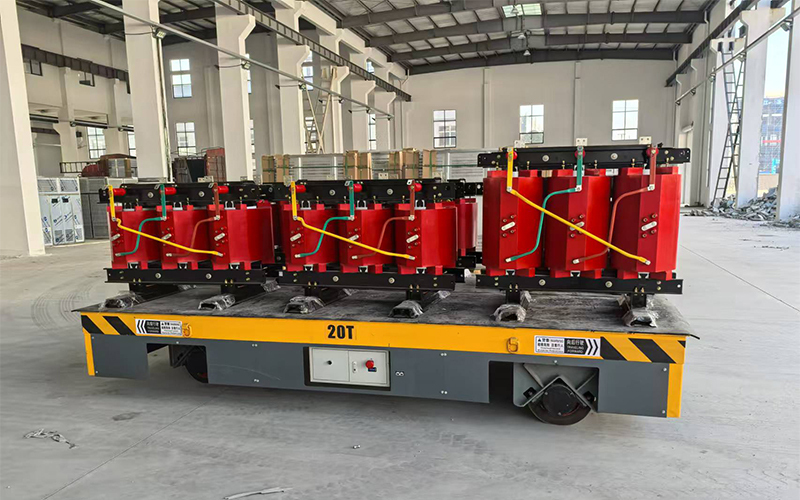
2 AGV Transfer Cart
The AGV transfer cart represents the advanced level of modern industrial automation. It integrates advanced navigation technology, sensor systems, and intelligent control mechanisms, enabling autonomous navigation, automatic obstacle avoidance, and automatic loading and unloading of goods, among other functions. In modern smart factories, AGV transfer carts can be seamlessly connected with other equipment on the production line to automate the distribution and circulation of materials.
For example, in electronic chip manufacturing plants, chips need to be transported accurately and quickly between different production processes. AGV transfer carts can reliably move chips from the lithography area to the packaging area, and then to the testing area, based on preset programs and instructions. This greatly improves the level of automation and production efficiency while reducing labor costs and human error.
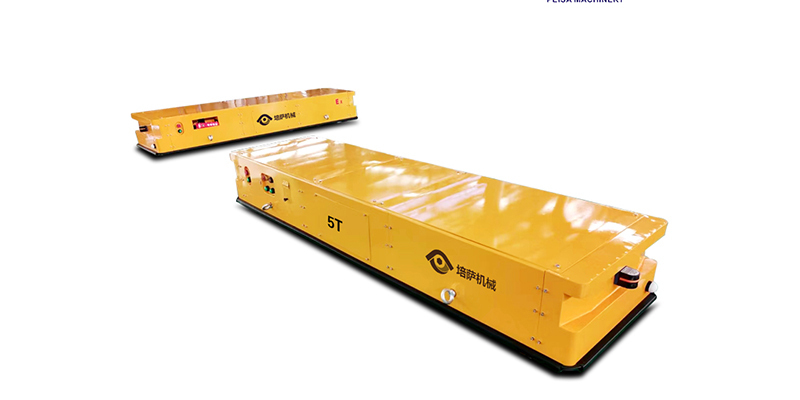
3. Horizontal Transfer Cart
The horizontal transfer cart stands out for its unique ability to move both vertically and horizontally. This allows it to achieve multi-directional movement in a confined space, providing greater flexibility for material transfer within the workshop. In some automotive parts processing workshops, where space is limited and parts processing equipment and storage areas are scattered, the horizontal trackless trolley can move both horizontally and vertically across the workshop floor. This allows it to quickly transport parts to various required stations, optimize the workshop's logistics layout, and improve space utilization.
Features: Since the area where customers transport molds is relatively compact and requires frequent direction changes, they choose a trackless trolley that can move both vertically and horizontally.
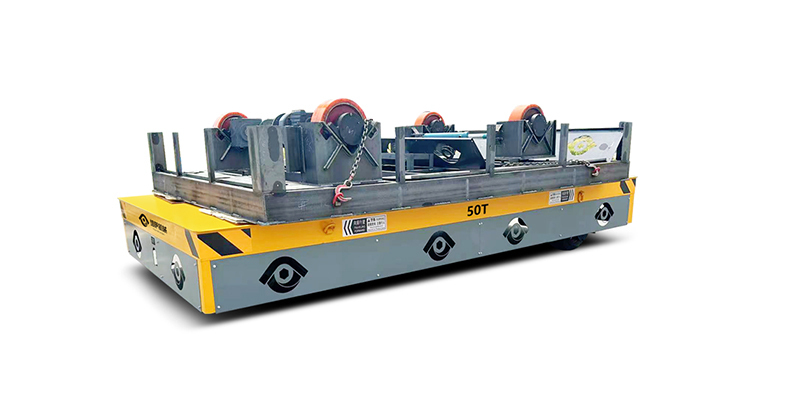
Customized Functions
Whether it is a rail transfer cart or a trackless trolley, we also offer non-standard customized functions to meet the specific transportation needs of different customers and workpieces. For example, adding a lifting function allows the cart to easily lift the workpiece to a certain height for docking or loading and unloading with other equipment. In the logistics and warehousing industry, for goods that need to be stacked on high shelves, a transfer cart with a lifting function can efficiently lift the goods to the appropriate position, facilitating effective warehouse management.
The rollover function is suitable for scenarios where workpieces need to be dumped or turned over. For example, in a foundry, when handling the casting mold of liquid metal, it may be necessary to roll it over at a specific angle during transportation for demoulding or cleaning. A transfer cart with a rollover function can perform this task safely and stably, improving both the convenience and flexibility of production.
The installation of facilities such as U-shaped grooves and V-shaped frames helps securely fix and carry workpieces with special shapes. In the machining industry, for parts like round shafts or V-shaped guide rails, U-shaped grooves and V-shaped frames can provide precise positioning and stable support to prevent the workpieces from rolling or sliding during transportation, ensuring both safety and quality.
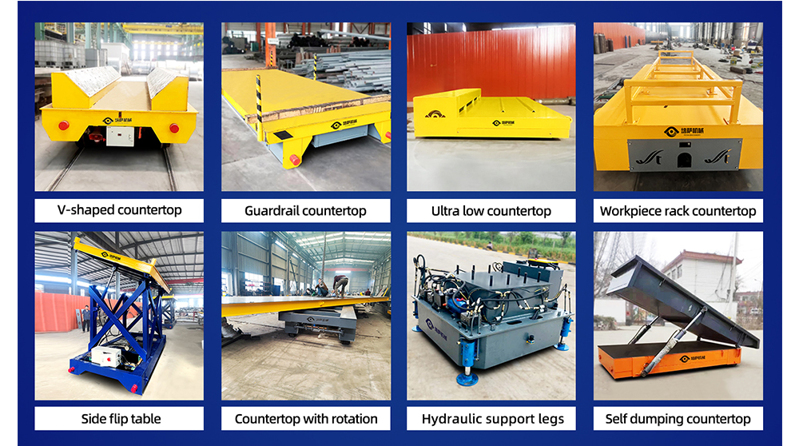

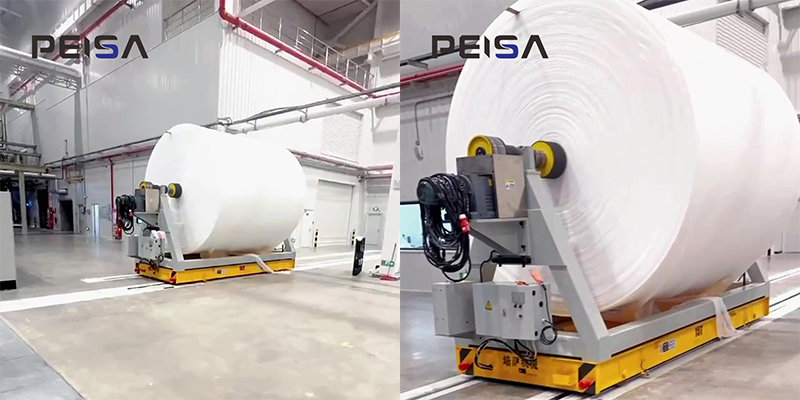

Message Board